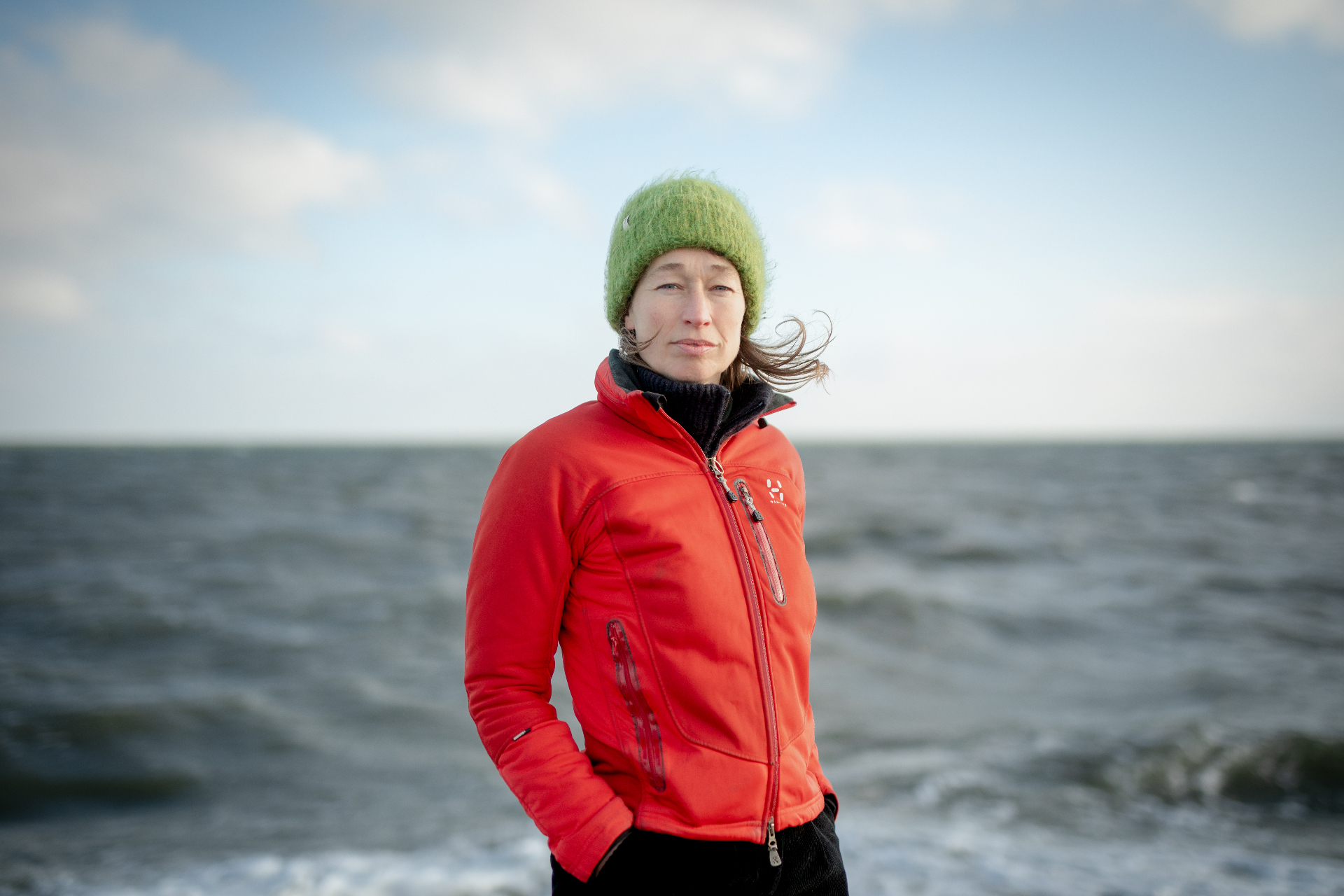Dr. Fleur Visser
Our influence on marine life
In the Coastal Systems Department (COS), marine biologist Fleur Visser researches the deeper parts of the seas and oceans. “I want to understand how marine life is affected by the noise, the changing climate or other human influences.”
The unknown deep sea
“When you argue that protecting marine life begins with knowledge, we have to recognize that we still know very little about many of its creatures, including marine mammals. Almost half of all whale species hunt in the deep sea. Sperm whales, but also pilot whales, beaked whales or Risso’s dolphins look for their food at large depths, from 100s of meter to up to three kilometers deep. We know this because we can temporarily put small sensors on whales to follow them underwater. But why do so many cetaceans use the deep sea as a hunting ground, rather than shallower water, where the density of squid - their prey animals - seems higher than in the deep sea?”
The nutritional value of squid
“To investigate this, I combine field studies near the Azores with research in the laboratory. There, with colleagues of GEOMAR, we look at environmental or ‘eDNA’ and the energetic composition, or rather, the nutritional value of prey animals,. In the field we do long-term measurements on the sea floor, in cooperation with the SCRIPPS Institution of Oceanography.
From these stuies it appears that deeper living squids may provide more nutritional value because they are larger, and contain more energy. These are important first steps in understanding why and how top predators have adapted to become hunters of the deep sea.”
Disturbing noise
“My research began by testing the effects of noise on cetaceans. These animals may avoid areas, or adjust their hunting behavior, when confronted with noise. In rare but nevertheless severe cases, cetaceans may even become stranded due to noise exposure.
Cetaceans, as well as their prey, and marine life in general, are highly dependent on sound, and thus are sensitive to disturbance from human noise sources. This means that when disturbance occurs, there is not only a direct effect on an animal, but also an indirect effect, such as a change in the behavior or distribution of their prey.
New developments such as deep-sea mining developments may also have implications for these animals. For example, the dust plumes that may be created around the areas where minerals will be extracted from the seafloor, may still have unexpected and undescribed effects. What effect will this turbidity have on prey animals that communicate with light - bioluminescence?”
Fundamental understanding
“To understand when and why a disturbance has effects and whether they translate to the population level and on the balance of the food web, we must first understand the basics of the system. With my work, therefore, I hope to contribute to a better fundamental understanding of the food web and ecology of the deep sea, with the ultimate aim to help define and reduce the consequences of our marine activities.”
Specialisation
Whale and dolphin social and foraging ecology, impacts of anthropogenic stressors

Research interests
Functions
Key publications
Please find my list of publications at the bottom of this webpage or on GoogleScholar.
Professional education
Awards and Prizes
Other
Linked news
Linked blogs
NIOZ publications
-
2024
Hoving, H.-J.; Visser, F (2024). Whales and cephalopods in a deep‐sea arms race. Limnology and Oceanography Letters 9(3): 165-171. https://dx.doi.org/10.1002/lol2.10391Southall, B.L.; Durban, J.W.; Calambokidis, J.; Casey, C.; Fahlbusch, J.A.; Fearnbach, H.; Flynn, K.R.; Fregosi, S.; Friedlaender, A.S.; Leander, S.G.M.; Visser, F (2024). Behavioural responses of common dolphins to naval sonar. Royal Society Open Science 11(10): 240650. https://dx.doi.org/10.1098/rsos.240650
-
2023
Merten, V.; Visser, F; Hoving, H.-J. (2023). Deep-sea predator-prey dynamics revealed by biologging and eDNA analysis. Oceanography 36(1): 96-99. https://dx.doi.org/10.5670/oceanog.2023.s1.31
-
2022
Arranz, P.; Christiansen, F.; Glarou, M.; Gero, S.; Visser, F; Oudejans, M.G.; Aguilar de Soto, N.; Sprogis, K. (2022). Body condition and allometry of free-ranging short-finned pilot whales in the North Atlantic. Sustainability 14(22): 14787. https://dx.doi.org/10.3390/su142214787Pachiadaki, M.; Janssen, F.; Carreiro-Silva, M.; Morato, T.; Carreira, G.P.; Frazão, H.C.; Heimbach, P.; Iglesias, I.; Müller-Karger, F.E.; dos Santos, M.N.; Smith, L.M.; Vardaro, M.F.; Visser, F; Waniek, J.J.; Zinkann, A.-C.; Colaço, A. (2023). Co-designing a multidisciplinary deep-ocean observing programme at the Mid-Atlantic Ridge in the Azores region: a blueprint for synergy in deep ocean research and conservation. ICES J. Mar. Sci./J. Cons. int. Explor. Mer 80(2): 352-354. https://dx.doi.org/10.1093/icesjms/fsac189Visser, F; Oudejans, M.G.; Keller, O.A.; Madsen, P.T.; Johnson, M. (2022). Sowerby's beaked whale biosonar and movement strategy indicate deep-sea foraging niche differentiation in mesoplodont whales. J. Exp. Biol. 225(9): jeb243728. https://dx.doi.org/10.1242/jeb.243728
-
2021
Visser, F.; Mertens, V.; Bayer, T.; Oudejans, M.G.; de Jonge, D.S.W.; Puebla, O.; Reusch, T.B.H.; Fuss, J.; Hoving, H.J.T. (2021). Deep-sea predator niche segregation revealed by combined cetacean biologging and eDNA analysis of cephalopod prey. Science Advances 7(14): eabf5908. https://doi.org/10.1126/sciadv.abf5908
-
2020
Kok, A.C.M.; van Kolfshoten, L.; Campbell, J.A.; von Benda-Beckmann, A.M.; Miller, P.J.O.; Slabbekoorn, H.; Visser, F (2020). Diving apart together: call propagation in diving long-finned pilot whales. J. Exp. Biol. 223(10): jeb207878. https://doi.org/10.1242/jeb.207878
-
2019
Gough, W.T.; Segre, P.S.; Bierlich, K.C.; Cade, D.E.; Potvin, J.; Fish, F.E.; Dale, J.; di Clemente, J.; Friedlaender, A.S.; Johnston, D.W.; Kahane-Rapport, S.R.; Kennedy, J.; Long, J.H.; Oudejans, M.; Penry, G.; Savoca, M.S.; Simon, M.; Videsen, S.K.A.; Visser, F.; Wiley, D.N.; Goldbogen, J.A. (2019). Scaling of swimming performance in baleen whales. J. Exp. Biol. 222(20): jeb204172. https://dx.doi.org/10.1242/jeb.204172